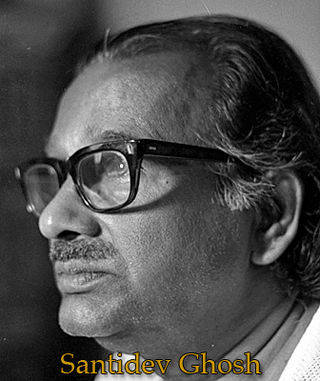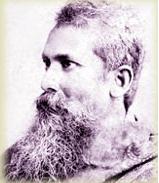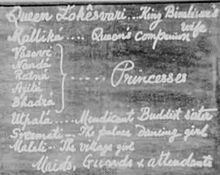
Shantiniketan is a neighbourhood of Bolpur town in the Bolpur subdivision of Birbhum district in West Bengal, India, approximately 152 km north of Kolkata. It was established by Maharshi Devendranath Tagore, and later expanded by his son, Rabindranath Tagore whose vision became what is now a university town with the creation of Visva-Bharati.

Pankaj Kumar Mullick was an Indian music composer, playback singer and actor, who was a pioneer of film music in Bengali cinema and Hindi cinema at the advent of playback singing, as well as an early exponent of Rabindra Sangeet.

New Theatres is an Indian film studio. It was formed in Calcutta by producer B. N. Sircar. It was formed on 10 February 1931. Motto of this company was– Jivatang Jyotiretu Chhayam. Sircar preferred to function roughly analogous to what in USA was known as an executive producer. He built a processing laboratory... and got around him a devoted band of people.... Having decided on or approved a story or a subject for a film and the team to make it [Sircar] ensured that adequate funds were provided... but refrained from interfering with its execution. He made New Theatres a symbol of Bengali cinema's artistic good taste and technical excellence.

Kanika Banerjee was an Bengali Rabindra Sangeet singer.

Nandalal Bose was one of the pioneers of modern Indian art and a key figure of Contextual Modernism.

Rabindranath Tagore is a 1961 Indian documentary film written and directed by Satyajit Ray about the life and works of noted Bengali author Rabindranath Tagore. Ray started working on the documentary in early 1958. Shot in black-and-white, the finished film was released during the birth centenary year of Rabindranath Tagore, who was born on 7 May 1861. Ray avoided the controversial aspects of Tagore's life in order to make it as an official portrait of the poet. Though Tagore was known as a poet, Ray did not use any of Tagore's poetry as he was not happy with the English translation and believed that "it would not make the right impression if recited" and people would not consider Tagore "a very great poet," based on those translations. Satyajit Ray has been reported to have said about the documentary Rabindranath Tagore in his biography Satyajit Ray: The Inner Eye by W. Andrew Robinson that, "Ten or twelve minutes of it are among the most moving and powerful things that I have produced."

Suchitra Mitra was an Indian singer, composer, artist exponent of Rabindra Sangeet or the songs of Bengal's poet laureate Rabindranath Tagore, professor, and the first woman Sheriff of Kolkata. As an academic, she remained a professor and the Head of Rabindra Sangeet Department at the Rabindra Bharati University for many years. Mitra was a playback singer in Bengali films and was associated for many years with the Indian People's Theatre Association.

The culture of West Bengal is an Indian culture which has its roots in Bengali literature, music, fine arts, drama and cinema. Different geographic regions of West Bengal have subtle as well as more pronounced variations between each other, with Darjeeling Himalayan hill region and Duars showing particularly different socio-cultural aspects.

Santidev Ghose was an Indian author, singer, actor, dancer and maestro of Rabindra Sangeet.

Nitin Bose was an Indian film director, cinematographer and screenwriter of the nation's film industry. He was born in Calcutta and died in the same city. In the 1930s and early 40s, he worked with New Theatres, who made bilingual movies: in both Bengali and Hindi. Later, he moved to Bombay and directed under the banners of Bombay Talkies and Filmistan.
Premankur Atorthy (1890–1964) was an Indian novelist, journalist, and film director. He was involved in Hindi and Bengali cinema.

Shyamanand Jalan was a Kolkata-based Indian theatre director, and actor. He is credited for the renaissance period of modern Indian theatre and especially the Hindi theatre in Kolkata from the 1960s to 1980s. He was the first to perform modernist Mohan Rakesh, starting with Ashadh Ka Ek Din in 1960 and in the coming years bridged the gap between Hindi theatre and Bengali theatre, by mounting Hindi productions of works by Bengali playwrights, like Badal Sircar's Evam Indrajit (1968) and Pagla Ghora (1971), which in turn introduced Sircar to rest of the country. In 2005, he directed his first and only film Eashwar Mime Co., which was an adaptation of Dibyendu Palit's story, Mukhabhinoy, by Vijay Tendulkar.

Dinendranath Tagore, also known as Dinu Thakur, was a Bengali musician, singer and poet.

Birendranath Sircar was an Indian film producer and the founder of New Theatres Calcutta. He made Bengali-language films that were noted for introducing many film directors who later became famous. He was awarded the Dada Saheb Phalke Award in 1970 and the third highest civilian award in India, the Padma Bhushan, in 1972.

Muktodhara is a 2012 Bengali film directed by Shiboprosad Mukherjee and Nandita Roy. This is a story about the prisoners of a correctional home ‒ Presidency jail who all have a dark past life but here they are being reformed day by day.

Pratima Devi (1893–1969) was an Indian Bengali artist, widely known for her artistic abilities. She was wife of Rathindranath Tagore. The poet took special interest in developing her capabilities.
Hamrahi (transl. Companion/Partner), is a 1945 Hindi social drama film of Indian Cinema. The film was a bilingual, and was a remake of its popular Bengali version called Udayer Pathey (1944). Bimal Roy, after working as a cinematographer with New Theatres, Calcutta, launched into feature film direction. Udayer Pathey was Roy's debut film as a director in Bengali films, while Hamrahi was his first directorial venture in Hindi cinema. The original story and dialogues for Bengali version were written by Jyotirmoy Roy, with the dialogues in Hindi written by Mohanlal Bajpai. Produced by New Theatres, Calcutta, the cinematographer was Bimal Roy. The music direction was by Raichand Boral and the lyrics were by Zakir Husain. The film included Rabindranath Tagore's song, "Jana Gana Mana", even before it became the national anthem of India.
The following is a list of notable people associated withVisva- Bharati University and/or Santiniketan, a neighbourhood in Bolpur city in West Bengal, India:

Sangit Bhavana, of Visva-Bharati University, Santiniketan, started functioning as a part of Kala Bhavana in 1919 and as a separate institution in 1933. It was established by the Nobel laureate Rabindranath Tagore.

Dwijendranath Tagore was an Indian Bengali poet, song composer, philosopher, mathematician and painter. He was one of the pioneers of shorthand and notation in Bengali script. He was the eldest son of Debendranath Tagore and the eldest brother of Rabindranath Tagore.



















